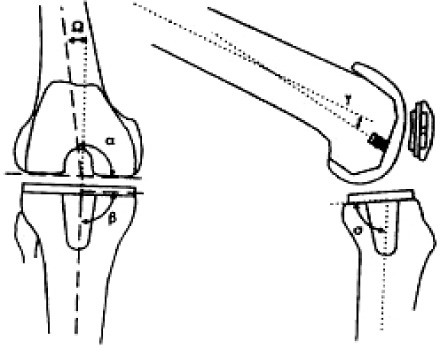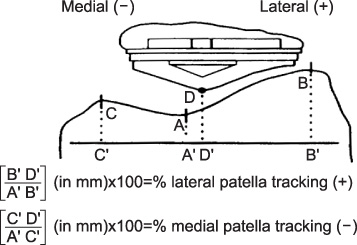J Korean Orthop Assoc.
2008 Feb;43(1):65-71. 10.4055/jkoa.2008.43.1.65.
A Comparison of Patella Retention versus Resurfacing in Total Knee Arthroplasty: A Minimum 7 Year Follow-up
- Affiliations
-
- 1Department of Orthopedic Surgery, Knee Center, Chung-Ang University College of Medicine, Seoul, Korea.
- 2Department of Orthopedic Surgery, Knee Center, Kangbuk Samsung Hospital, Sungkyunkwan University College of Medicine, Seoul, Korea. qortn97@naver.com
- KMID: 2106418
- DOI: http://doi.org/10.4055/jkoa.2008.43.1.65
Abstract
-
PURPOSE: To evaluate and report the clinical and radiological results of patients that had undergone patellar retention and resurfacing during total knee arthroplasty.
MATERIALS AND METHODS
From July 1993 to December 1999, 54 patients (73 cases) underwent total knee arthroplasty by one surgeon. We divided these patients into the patellar retention group and patellar resurfacing group, and compared the clinical and radiological results of the two groups. The indications of patellar retention were a small patella, nearly normal articular cartilage, minimal preoperative patellofemoral pain, poor patellar bone quality, and young patient age. In these cases, osteophytes of the patella were removed and marginal electrocauterization was performed. There were 32 patients (41 cases) in the patellar retention group and 22 patients (32 cases) in the patellar resurfacing group. The mean follow-up period was 106.7 months in the patellar retention group and 93.6 months in the patellar resurfacing group. We evaluated the patients using the knee rating system of the American Knee Society (knee score and functional score), knee arthroplasty rating system of the Hospital for Special Surgery (HSS score), patellofemoral score, range of motion of the knee joint, and performed a radiological evaluation by use of the radiographical evaluation system of the Knee Society at the last follow-up period. Also, to evaluate patellofemoral congruence, we used Keblish's method.
RESULTS
At the last follow-up, the mean knee score and functional score were 90.4 and 75.5 for the patellar retention group, and 86.1 and 70.0 for the patellar resurfacing group, respectively (p=0.29, p=0.27). The HSS score was 85.2 for the patellar retention group and 84.8 for the patellar resurfacing group (p=0.30). The Bristol patellar score and Lonner Patellofemoral score were 8.7 and 82.0 for the patellar retention group and 8.8 and 85.6 for the patellar resurfacing group, repectively (p=0.86, p=0.86). The mean value of the patellofemoral score was slightly higher in the patellar resurfacing group, but statistically there was no difference between the two groups. There were also no statistically differences in the others parameters.
CONCLUSION
We obtained favorable results by selective patellar resurfacing total knee arthroplasty, although there were no significant differences for both the patellar retention and resurfacing group. We believe that it may be better to select a proper indication than to just follow the preference of the surgeon for patellar resurfacing.
MeSH Terms
Figure
Reference
-
1. Aglietti P, Insall JN, Walker PS, Trent P. A new patella prosthesis. Design and application. Clin Orthop Relat Res. 1975. 107:175–187.2. Badalamente MA, Cherney SB. Periosteal and vascular innervation of the human patella in degenerative joint disease. Semin Arthritis Rheum. 1989. 18:Suppl 2. 61–66.
Article3. Bargren JH, Freeman MA, Swanson SA, Todd RC. ICLH (Freeman/Swanson) arthroplasty in the treatment of arthritic knee: a 2 to 4-year review. Clin Orthop Relat Res. 1976. 120:65–75.4. Barrett WP, Scott RD. Revision of failed unicondylar unicompartmental knee arthroplasty. J Bone Joint Surg Am. 1987. 69:1328–1335.5. Brick GW, Scott RD. The patellofemoral component of total knee arthroplasty. Clin Orthop Relat Res. 1988. 231:163–178.
Article6. Burnett RS, Haydon CM, Rorabeck CH, Bourne RB. Patella resurfacing versus nonresurfacing in total knee arthroplasty: results of a randomized controlled clinical trial at a minimum of 10 years' followup. Clin Orthop Relat Res. 2004. 428:12–25.7. Cameron HU, Fedorkow DM. The patella in total knee arthroplasty. Clin Orthop Relat Res. 1982. 165:197–199.
Article8. Cameron HU, Jung YB. A comparison of unicompartmental knee replacement with total knee replacement. Orthop Rev. 1988. 17:983–988.9. Dalury DF, Ewald FC, Christie MJ, Scott RD. Total knee arthroplasty in a group of patients less than 45 years of age. J Arthroplasty. 1995. 10:598–602.
Article10. Goodfellow J, Hungerford DS, Zindel M. Patello-femoral joint mechanics and pathology. 1. Functional anatomy of the patello-femoral joint. J Bone Joint Surg Br. 1976. 58:287–290.
Article11. Goodfellow JW, Kershaw CJ, Benson MK, O'Connor JJ. The Oxford Knee for unicompartmental osteoarthritis. The first 103 cases. J Bone Joint Surg Br. 1988. 70:692–701.
Article12. Gunston FH, MacKenzie RI. Complications of polycentric knee arthroplasty. Clin Orthop Relat Res. 1976. 120:11–17.
Article13. Halata Z, Badalamente MA, Dee R, Propper M. Ultrastructure of sensory nerve endings in monkey (Macaca fascicularis) knee joint capsule. J Orthop Res. 1984. 2:169–176.
Article14. Halata Z, Rettig T, Schulze W. The ultrastructure of sensory nerve endings in the human knee joint capsule. . Anat Embryol (Berl). 1985. 172:265–275.
Article15. Heck DA, Marmor L, Gibson A, Rougraff BT. Unicompartmental knee arthroplasty. A multicenter investigation with long-term follow-up evaluation. Clin Orthop Relat Res. 1993. 286:154–159.16. Hernigou P, Deschamps G. Patellar impingement following unicompartmental arthroplasty. J Bone Joint Surg Am. 2002. 84:1132–1137.
Article17. Huberti HH, Hayes WC. Patellofemoral contact pressures. The influence of q-angle and tendofemoral contact. J Bone Joint Surg Am. 1984. 66:715–724.
Article18. Insall J, Scott WN, Ranawat CS. The total condylar knee prosthesis. A report of two hundred and twenty cases. J Bone Joint Surg Am. 1979. 61:173–180.
Article19. Insall J, Tria AJ, Scott WN. The total condylar knee prosthesis: the first 5 years. Clin Orthop Relat Res. 1979. 145:68–77.20. Jung YB, Yum JK, Lee JW, Jang EC. Comparison of patella retention versus resurfacing in total knee arthroplasty: preliminary report. J Korean Orthop Assoc. 1997. 32:1475–1480.
Article21. Keblish PA, Varma AK, Greenwald AS. Patellar resurfacing or retention in total knee arthroplasty. A prospective study of patients with bilateral replacements. J Bone Joint Surg Br. 1994. 76:930–937.
Article22. Laurencin CT, Zelicof SB, Scott RD, Ewald FC. Unicompartmental versus total knee arthroplasty in the same patient. A comparative study. Clin Orthop Relat Res. 1991. 273:151–156.23. Laurin CA, Dussault R, Levesque HP. The tangential x-ray investigation of the patellofemoral joint: x-ray technique, diagnostic criteria and their interpretation. Clin Orthop Relat Res. 1979. 144:16–26.24. Levai JP, McLeod HC, Freeman MA. Why not resurface the patella? J Bone Joint Surg Br. 1983. 65:448–451.
Article25. Levitsky KA, Harris WJ, McManus J, Scott RD. Total knee arthroplasty without patellar resurfacing. Clinical outcomes and long-term follow-up evaluation. Clin Orthop Relat Res. 1993. 286:116–121.26. Merchant AC, Mercer RL, Jacobsen RH, Cool CR. Roentgenographic analysis of patellofemoral congruence. J Bone Joint Surg Am. 1974. 56:1391–1396.
Article27. Merkow RL, Soudry M, Insall JN. Patellar dislocation following total knee replacement. J Bone Joint Surg Am. 1985. 67:1321–1327.
Article28. Palmer SH, Morrison PJ, Ross AC. Early catastrophic tibial component wear after unicompartmental knee arthroplasty. Clin Orthop Relat Res. 1998. 350:143–148.
Article29. Ranawat CS. The patellofemoral joint in total condylar knee arthroplasty. Pros and cons based on five- to ten-year follow-up observations. Clin Orthop Relat Res. 1986. 205:93–99.30. Ranawat CS, Padgett DE, Ohashi Y. Total knee arthroplasty for patients younger than 55 years. Clin Orthop Relat Res. 1989. 248:27–33.
Article31. Rougraff BT, Heck DA, Gibson AE. A comparison of tricompartmental and unicompartmental arthroplasty for the treatment of gonarthrosis. Clin Orthop Relat Res. 1991. 273:157–164.
Article32. Shoji H, Yoshino S, Kajino A. Patellar replacement in bilateral total knee arthroplasty. A study of patients who had rheumatoid arthritis and no gross deformity of the patella. J Bone Joint Surg Am. 1989. 71:853–856.
Article33. Stern SH, Bowen MK, Insall JN, Scuderi GR. Cemented total knee arthroplasty for gonarthrosis in patients 55 years old or younger. Clin Orthop Relat Res. 1990. 260:124–129.34. Swank M, Stulberg SD, Jiganti J, Machairas S. The natural history of unicompartmental arthroplasty. An eight-year follow-up study with survivorship analysis. Clin Orthop Relat Res. 1993. 286:130–142.35. Vince KG, McPherson EJ. The patella in total knee arthroplasty. Orthop Clin North Am. 1992. 23:675–686.
Article36. Waters TS, Bentley G. Patellar resurfacing in total knee arthroplasty. A prospective, randomized study. J Bone Joint Surg Am. 2003. 85:212–217.
- Full Text Links
- Actions
-
Cited
- CITED
-
- Close
- Share
- Similar articles
-
- Comparative Analysis between Patellar Resurfacing and Retention in Total Knee Arthroplasty: 5-year Follow-up Result
- A Comparison of Patella Retention versus Resurfacing for Moderate or Severe Patellar Articular Defects in Total Knee Arthroplasty: Minimum 5-year Follow-up Results
- Comparison of Patella Retention Versus Resurfacing in Total Knee Arthroplasty: Preliminary report
- Comparison of the Results of Resurfacing Versus Non Resurfacing the Patella after Total Knee Arthroplasties in the Same Patient
- Total Knee Replacement Arthroplasty Without Patellar Resurfacing




